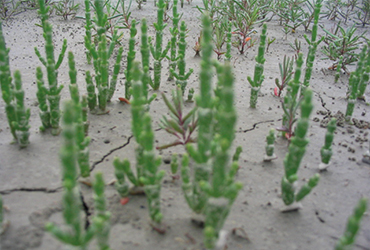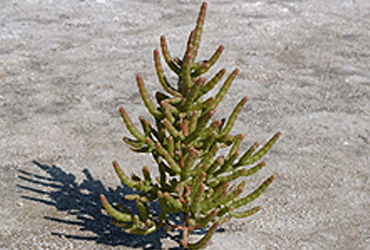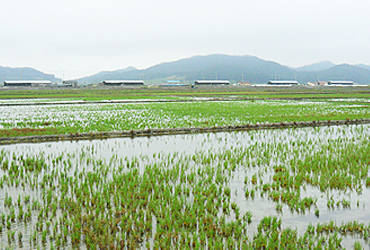Korean Glasswort The Story
> Areas of Business > Primary Industry > Korean Glasswort | The Story
Production and distribution of the processed Natural Sea Salt, glasswort and salt-related products
How come the glasswort from the Taepyung Salt Farm is organic?
Natural glasswort habitat of Taepyung Salt Farm retains its natural state
Glasswort is a salt plant that grows mainly in the first evaporating pond in groups. Some salt farms would let the glasswort parched to death by spraying weedkiller on them for the reason that the glasswort suck in salt and adversely affect the evaporation of moisture. They have a point because the salt plans such as glasswort in the salt farm is the main reason of a significant drop in the production. In Taepyung Salt Farm where no synthetic detergents and pesticides are used, however, even those glassworts are cultivated in their natural state. For this reason, the glasswort from the Taepyung Salt Farm has been certified as Organic Agricultural Product (Certification No. 16-1-32) as eco-friendly food. This is indeed what decreased the production of Natural Sea Salt, but our Natural Sea Salt is low in salinity and contains minerals coming from the glasswort and the tidal flat. Taepyung Salt Farm that has the pure natural form as it is keeps up with its reputation as the Ecological Grand Slam so as to produce quality Natural Sea Salt and organic glassworth by according with the natural environment.



Taepyung Salt Farm’s glasswort plantation area 1,485,000m² (450,000 pyeong)
Glasswort and Minerals
Glasswort contains 90 types of minerals, which is 40 times more the content of dried laver, 200 times the spinach, Ca (calcium) is 5 times higher than the milk, Fe (iron) is 2 to 5 times more than the seaweed, K (potassium) is 3 times higher than the potatoes and I (iodine) is 8 times more than the recommended daily dose. The mineral content contained in the glasswort is what absorbed the seawater and the minerals of the sea to be three times higher than that of the broccoli. When the water is evaporated to be dried, the mineral content is concentrated 4 to 6 times for even stronger effect.
(Source: National Institute of Fisheries Sciences. October 1999)
Contents of Minerals Glasswort (mg/100g)
| Mineral | Portion | ||
|---|---|---|---|
| leaf | stem | root | |
| Sodium (Na) | 1003.4 | 1218.1 | 1333.8 |
| Calcium (Ca) | 237.5 | 158.8 | 22.1 |
| Potassium (K) | 650.1 | 740.1 | 741.1 |
| Magnesium (Mg) | 46.5 | 54.0 | 52.5 |
| Zinc (Zn) | 13.4 | 29.6 | 2.4 |
| 철(Fe) | 31.5 | 66.2 | 84.8 |
| Iron (Fe) | 3.1 | 1.1 | 2.1 |
| Copper (Cu) Nickel (Ni) | 1.1 | 0.7 | 0.4 |
| Manganese (Mn) | 7.2 | 3.9 | 3.0 |
(Source: National Institute of Fisheries Sciences. (Fishery Research Fellow Lee Doo-seok, Fishery Researcher Min Jin-gi)
Salt plant from the sea and tidal flats
It has been found that the glasswort contains not only minerals but also essential amino acids and polysaccharides such as Valnine, Leucine and Proline.
In addition, glasswort grows in the environment of high-concentration salt as a salt plant, therefore, it retains various beneficial ingredients to adapt to salt stress environment.
What a gift from the sea and tidal flats!
Total amino acid compositions in Glasswort
| Amino acid | Portion | ||
|---|---|---|---|
| leaf | stem | root | |
| Taurine | 7.6(0.6) | 21.4(1.3) | 37.7(2.4) |
| Aspartic acid | 137.1(10.8) | 140.2(8.6) | 165.5(10.6) |
| Threonine | 70.9(5.6) | 69.8(4.3) | 81.2(5.2) |
| Serine | 67.5(5.3) | 72.7(4.5) | 94.8(6.0) |
| Glutamic acid | 144.8(11.4) | 160.5(9.9) | 182.3(11.6) |
| Glycine | 76.9(6.1) | 80.4(4.9) | 122.9(7.8) |
| Alanine | 76.9(6.1) | 88.7(5.5) | 98.2(6.2) |
| Cystine | 11.1(1.2) | ||
| Valine | 72.9(5.7) | 126.1(7.8) | 94.7(6.0) |
| Methionine | 23.2(1.8) | 52.2(3.2) | 23.3(1.5) |
| llelucine | 110.7(8.7) | 107.5(6.6) | 94.7(6.0) |
| Leucine | 115.5(9.1) | 98.1(6.0) | 128.4(8.2) |
| Tyrosine | 10.8(0.9) | ||
| Phelyalanine | 73.2(5.8) | 63.3(3.9) | 67.7(4.3) |
| Lysine | 79.8(6.3) | 310.2(19.1) | 178.9(11.4) |
| Histidine | 34.0(2.7) | 179.3(11.0) | 54.4(3.5) |
| Arginine | 77.0(6.1) | 36.1(2.2) | 57.0(3.6) |
| Proline | 88.5(7.0) | 18.4(1.1) | 86.8(5.5) |
| Total | 1,270(100) | 1,625(100) | 1,569(100) |
(Source: National Institute of Fisheries Sciences. (Fishery Research Fellow Lee Doo-seok, Fishery Researcher Min Jin-gi)
Proximate compositions and Salt in Glasswort (mg/100g)
| Items | Portion | ||
|---|---|---|---|
| leaf | stem | root | |
| Moisture | 90.9(2.4) | 73.9(2.9) | 66.2(1.7) |
| Crude protein | 1.6(16.5) | 2.0(7.6) | 2.0(5.7) |
| Crude lipid | 0.2(2.6) | 0.3(1.3) | 0.3(1.0) |
| Crude ash | 4.7(50.0) | 6.1(22.6) | 6.2(18.0) |
| Salt | 3.3(35.3) | 3.9(14.4) | 2.8(8.0) |
(Source: National Institute of Fisheries Sciences. (Fishery Research Fellow Lee Doo-seok, Fishery Researcher Min Jin-gi)
Sugers Portion Meen
| Sugers | Portion | Meen | ||
|---|---|---|---|---|
| leaf | stem | root | ||
| Uronic aoid | 0.31(3.37) | 1.40(5.22) | 1.88(5.48) | 1.20(4.69) |
| Reducing suger | 1.56(16.72) | 7.84(31.62) | 13.36(38.84) | 7.59(29.06) |
| Non-reducing | 0.64(6.84) | 5.57(18.30) | 9.44(27.48) | 5.21(17.54) |
| Total suger | 2.20(23.56) | 13.41(49.92) | 22.80(66.32) | 12.80(46.60) |
(Source: National Institute of Fisheries Sciences. (Fishery Research Fellow Lee Doo-seok, Fishery Researcher Min Jin-gi))
Efficacy of Glasswort
Glasswort contains Betaine, a digestive component that helps digestion with taurine, and a betaine is known to help detoxify the liver. The efficacy of glasswort containing a betaine functions to improve liver function, atherosclerosis, diabetes, and kidney disease. Glasswort contains dietary fiber for the intestines, functional polysaccharides that improve immunity, and other inorganic salts. These substances are resistant to heat, making it easy to use for cooking at home. Glasswort has the efficacy of driving through what is clogged, thus, it is advised not to use on the pregnant women, menstruating women, and those who would have watery feces as much as possible.
Besides, the glasswort has proved to be very high functional in the test of cholesterol, antioxidant capacity, amino acid content component, and demonstrated high content of vitamins as well as minerals. Likewise, the glasswort displayed almost the equal level of muscle strengthening effect as the red ginseng does. Studies on the functionality of the glasswort are steadily under development.




